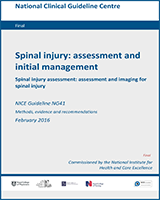NCBI Bookshelf. A service of the National Library of Medicine, National Institutes of Health.
Excerpt
The scope of this guideline is the assessment, imaging and early management of spinal injury and does not address rehabilitation. It is important to recognise that early management is intrinsically connected to rehabilitation and some later complications may be avoided with changes in early care. Early and ongoing collaborative multidisciplinary care across a trauma network is vital in ensuring that the patient with a spinal injury receives the best possible care.
Contents
- Guideline Development Group members
- Guideline Development Group expert members
- Project Executive Team members
- NCGC technical team members
- Peer reviewers
- Acknowledgements
- 1. Foreword
- 2. Introduction
- 3. Development of the guideline
- 4. Methods
- 5. Guideline summary
- 6. Protecting the spine
- 6.1. Introduction
- 6.2. Review question: What is the clinical and cost effectiveness of routine spinal protection of all children, young people and adults experiencing trauma compared to selective protection, based on the use of a risk tool/clinical assessment at the scene of the incident/presentation?
- 6.3. Clinical evidence
- 6.4. Economic evidence
- 6.5. Evidence statements
- 6.6. Recommendations and link to evidence
- 7. Spinal injury assessment risk tools
- 7.1. Introduction
- 7.2. Review question: What tools are most predictive of spinal injury in people with suspected traumatic spinal injury when trying to exclude spinal cord injury (with or without spinal column injury) or isolated spinal column injury?
- 7.3. Clinical evidence
- 7.4. Economic evidence
- 7.5. Evidence statements
- 7.6. Recommendations and link to evidence
- 8. Immobilising the spine: pre-hospital strategies
- 8.1. Introduction
- 8.2. Review question: What pre-hospital strategies to protect the spine in people with suspected spinal injury are the most clinically and cost effective during transfer from the scene of the incident to acute medical care?
- 8.3. Clinical evidence
- 8.4. Economic evidence
- 8.5. Evidence statements
- 8.6. Recommendations and link to evidence
- 9. Destination (immediate)
- 9.1. Introduction
- 9.2. Review question: What is the optimal immediate destination of a person at risk of a traumatic spinal column injury?
- 9.3. Clinical evidence
- 9.4. Economic evidence
- 9.5. Evidence statements
- 9.6. Review question: What is the optimal immediate destination of a person at risk of a traumatic spinal cord injury?
- 9.7. Clinical evidence
- 9.8. Economic evidence
- 9.9. Evidence statements
- 9.10. Recommendations and link to evidence
- 10. Diagnostic imaging
- 10.1. Introduction
- 10.2. Review question: a) What is the diagnostic accuracy of i) X-ray, ii) dynamic fluoroscopy, iii) CT and iv) MRI, for people with spinal cord injury (with or without column injury)? b) What is the diagnostic accuracy of i) X-ray, ii) dynamic fluoroscopy, iii) CT and iv) MRI, for people with isolated spinal column injury?
- 10.3. Clinical evidence
- 10.4. Economic evidence
- 10.5. Evidence statements
- 10.6. Recommendations and link to evidence
- 11. Radiation risk
- 12. Further imaging
- 12.1. Introduction
- 12.2. Review question: For people who have clinical signs of traumatic spinal cord or column injury, but who have normal or indeterminate findings on imaging, what is the most clinically and cost effective further imaging strategy?
- 12.3. Clinical evidence
- 12.4. Economic evidence
- 12.5. Evidence statements
- 12.6. Recommendations and link to evidence
- 13. Spinal cord decompression
- 14. Timing of referral to tertiary services
- 15. Referral to a Spinal Cord Injury Centre
- 16. Neuroprotective pharmacological interventions
- 16.1. Introduction
- 16.2. Review question: What is the clinical and cost-effectiveness of neuroprotective pharmacological interventions (such as anti-inflammatories, antioxidants and anti-excitotoxins) in people with spinal cord injury during the acute stage?
- 16.3. Clinical evidence
- 16.4. Economic evidence
- 16.5. Evidence statements
- 16.6. Recommendations and link to evidence
- 17. Neuropathic pain
- 17.1. Introduction
- 17.2. Review question: What are the optimum strategies given in the acute management stage to prevent later neuropathic pain in people with traumatic spinal cord injury?
- 17.3. Clinical evidence
- 17.4. Economic evidence
- 17.5. Evidence statements
- 17.6. Recommendations and link to evidence
- 18. Information and support
- 18.1. Introduction
- 18.2. Review question: a) What information and support do people with suspected traumatic spinal cord/column injury and their families want in the early stages after trauma before a definitive diagnosis has been made? b) What information and support do people with a confirmed traumatic spinal cord/column injury and their families want in the early stages after trauma before transfer to specialist care?
- 18.3. Clinical evidence
- 18.4. Economic evidence
- 18.5. Evidence statements
- 18.6. Recommendations and link to evidence
- 19. Documentation
- 20. Access to the skills required for the management of people with spinal injury
- 21. Acronyms and abbreviations
- 22. Glossary
- Reference list
- Appendices A - F
- Appendices G - I
- Appendices J - P
- Appendix J. Excluded clinical studies
- Appendix K. Excluded economic studies
- Appendix L. Cost-effectiveness analysis: Diagnosis of traumatic spinal injury
- Appendix M. TARN Immobilisation costing
- Appendix N. Research recommendations
- Appendix O. NICE Technical team
- Appendix P. Qualitative study checklist (per theme)
- References
Disclaimer: Healthcare professionals are expected to take NICE clinical guidelines fully into account when exercising their clinical judgement. However, the guidance does not override the responsibility of healthcare professionals to make decisions appropriate to the circumstances of each patient, in consultation with the patient and/or their guardian or carer.
- NLM CatalogRelated NLM Catalog Entries
- Spinal Injury: Assessment and Initial ManagementSpinal Injury: Assessment and Initial Management
Your browsing activity is empty.
Activity recording is turned off.
See more...
